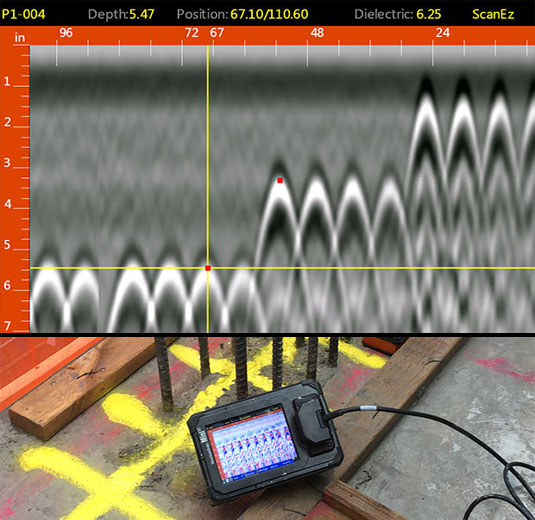Discovering the Depths: A Comprehensive Overview to Concrete Scanning and Its Diverse Applications
In the world of building and construction and infrastructure development, the careful procedure of concrete scanning holds a pivotal role in ensuring the structural integrity and safety of tasks. As modern technology continues to progress, the applications of concrete scanning have increased much beyond plain surface-level analyses.
Relevance of Concrete Scanning
Understanding the relevance of concrete scanning is essential in guaranteeing the safety and security and integrity of structures throughout building and construction and remodelling tasks. Concrete scanning uses advanced modern technologies such as ground-penetrating radar (GPR) and electro-magnetic induction to find ingrained items, gaps, or various other abnormalities within concrete structures.
Moreover, concrete scanning plays an essential role in guaranteeing compliance with building regulations and policies that mandate the security of existing structural components during construction activities. By precisely mapping out the internal structure of concrete, scanning technologies make it possible for building professionals to make informed decisions that maintain the architectural stability and resilience of structures and facilities projects. Fundamentally, the importance of concrete scanning lies in its capability to protect both the structural integrity and the personnel associated with building undertakings.
Technologies Utilized in Concrete Scanning
Concrete scanning counts on advanced innovations such as ground-penetrating radar (GPR) and electro-magnetic induction to precisely spot embedded items and abnormalities within concrete structures. Ground-penetrating radar runs by producing high-frequency electromagnetic waves right into the concrete. When these waves experience various products or gaps within the concrete, they recuperate to the surface area, allowing the GPR system to create an in-depth subsurface picture. This innovation is especially efficient in finding rebar, post-tension cords, conduits, and various other things embedded in concrete.
Electromagnetic induction, on the various other hand, functions by producing magnetic fields around a concrete framework via a transmitter coil. When metal objects exist within the concrete, they interrupt these electro-magnetic fields, causing eddy currents to stream via the metal. By measuring the changes in the electro-magnetic areas with a receiver coil, the system can pinpoint the location of metal objects in the concrete.
These innovative innovations play a vital duty in non-destructive testing, guaranteeing the safety and honesty of concrete structures in numerous markets.
Applications in Building Industry
Within the building sector, concrete scanning technology discovers varied applications that boost job performance and safety. One key application is the detection of rebar, post-tension cable televisions, and other ingrained things prior to drilling or reducing into concrete frameworks. By precisely mapping out these elements, building teams can prevent expensive problems, make sure architectural integrity, and avoid possible safety dangers. Furthermore, concrete scanning is utilized for locating voids, such as air pockets or areas of deterioration within concrete, which can jeopardize the total strength of a framework. By recognizing these gaps early on, building and construction specialists can take required actions find this to resolve them and keep the longevity of the structure. Concrete scanning plays a vital duty in quality control by validating the thickness of concrete covers over reinforcement, making sure conformity with layout specs and standards. On the whole, the applications of concrete scanning in the building and construction sector contribute considerably to simplifying project operations, official site lowering dangers, and providing high-grade results.

Security Advantages of Concrete Scanning
In the realm of building safety, the application of concrete scanning modern technology provides a vital advantage in preemptively identifying prospective threats and fortifying structural honesty. By utilizing sophisticated scanning methods such as ground-penetrating radar (GPR) and electromagnetic induction, building and construction groups can accurately find rebar, post-tension cords, avenues, and other surprise objects within concrete structures. This positive method substantially lowers the risk of unintentional strikes throughout drilling, cutting, or coring activities, thus avoiding expensive damages, injuries, and job hold-ups.
In addition, concrete scanning boosts employee safety and security by providing real-time information regarding the structural condition of concrete elements. This data enables construction professionals to assess the integrity of existing structures, identify degeneration or issues, and make educated choices regarding repair service and upkeep treatments. By resolving possible safety issues without delay, concrete scanning adds to producing a protected workplace and minimizing the chance of architectural failings or mishaps on building sites. Inevitably, the security benefits of concrete scanning not just secure assets and lives yet likewise support sector requirements for quality and reliability.
Future Trends in Concrete Scanning
Arising developments in scanning modern technology are poised to reinvent the field of concrete assessment and evaluation. One major pattern that is gaining traction is the assimilation of synthetic knowledge (AI) and device discovering algorithms into concrete scanning gadgets. By harnessing the power of AI, these systems can evaluate huge quantities of data gathered continue reading this throughout scanning procedures to offer even more exact and detailed understandings right into the condition of concrete structures. This can aid in finding hidden problems, anticipating possible architectural failings, and also recommending maintenance techniques.
One more significant trend is the development of more straightforward and mobile scanning tools. Miniaturization of scanning devices permits easier accessibility to constrained areas and remote places, making evaluations much more thorough and reliable. Furthermore, developments in wireless interaction modern technologies allow real-time data transfer and analysis, promoting quicker decision-making procedures.
Furthermore, there is an expanding emphasis on sustainability in concrete scanning innovations - RainierGPR Concrete Scanning. Producers are progressively integrating environment-friendly materials and energy-efficient attributes right into their devices to lower ecological impact. These future fads are readied to enhance the performance, accuracy, and sustainability of concrete scanning techniques, shaping the market's future landscape
Final Thought
In verdict, concrete scanning plays a crucial function in the building and construction industry by guaranteeing the security and performance of various tasks. As modern technology advancements, the future of concrete scanning holds appealing growths for boosting construction processes.
